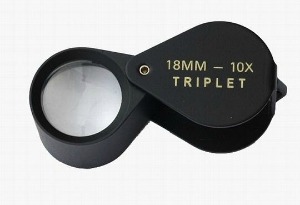How To Use A Jewelers Loupe
 The loupe should be 10X magnification because the Federal Trade Commission, in the United States, requires grading to be done under 10X power magnification.
The loupe should be 10X magnification because the Federal Trade Commission, in the United States, requires grading to be done under 10X power magnification.There's a less obvious reason why you should know how to use a Jewelers Loupe before you invest money in Antique Jewelry that retailers would prefer you didn't know.
It's a trade secret...
They say you can tell a lot about a tradesman by the way he uses his tools right? Likewise, you can tell a lot about a customer by the way he handles the Jeweler's Loupe (it's also called a hand lens).
If it becomes obvious to the dealer, that you don't know how to use a jewelers loupe, chances are, you don't know much about Antique Jewelry either.
There's a specific way to handle a jewelers loupe. Confidence on how to use a jewelers loupe is an Antique Jewelry Buying Basic!
The Jewelers Loupe can tell you important information that will help you a great deal, when you know how to use the instrument effectively.
If you're considering to invest in Antique Gold Jewelry, practice how to use a jewelers loupe, at home first, before you try impressing the dealer at your local Antique Jewelry store.
Knowing how to use a hand lens with confidence will provide the following two additional, less obvious benefits:
Jewelry loupes ( pronounced "loops" ) are a special type of magnifying glass. The jewelers loupe is a very practical tool to use once you master it and with practice it will become more and more valuable.
The one you need is a loupe 10 X ( ten power) triplet which can be obtained from any optical supplier.
Why the triplet-type?
The triplet type loupe is recommended because it corrects the two problems encountered using other types of magnifiers. These are:
- the presence of traces of color normally found at the outer edges of the lens
- visual distortion, also usually at the outer edge of the lens
Why must the loupe be 10 X magnification ?
The loupe should be 10 X magnification because the Federal Trade Commission, in the United states, requires grading to be done under 10 X power magnification.
*** Any flaws that do not show up under 10 X loupe magnification are considered non-existent for grading purposes.
5 Second Rule to Loupe Success
- Hold the jewelers loupe between the thumb and forefinger of either hand.
- Hold the object with the thumb and forefinger in the other hand.
- This step is important: now bring both hands together so that the bottom part of both thumbs come together, the thumb holding the loupe will rest on top of the other thumb. The lower wrists will become the pivotal point. Practice makes perfect :)
- Now move your hands close to your nose or cheek with the loupe as close to the eye as possible. You do not have to close the other eye. If you wear glasses you do not have to remove them.
- Steady Eddy - your hands must be steady for careful examination. This is how you steady your hands. With your hands together braced close to your face, holding the jewelers loupe in this position just described, put your elbows on a table or countertop. If there is no countertop available, brace your arms against your chest or rib-cage.
The loupe should be approximately one-inch from the eye and about an inch from the object being examined. A 10 x loupe is difficult at first to focus but with practice it becomes easier. Play with the object being examined and rotate it slowly, tilting it back and forward while looking at it with your loupe from different angles. Once you "get it" you will be able to see through loupe magnification in under 5 seconds!
Return to the top of How to Use A Jewelers Loupe
Return to Antique Jewelry Buying Basics
Return to Antique Jewelry Investor Home Page
